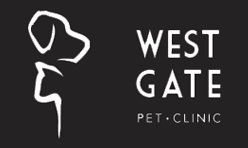Westgate Pet Clinic is proud to offer advanced diagnostics and treatment in the form of laparoscopic spay and gastropexy procedures, endoscopy and rhinoscopy at our clinic. Both Dr. Erik Melin and Dr. Brek Perry have had special training in the use of this equipment. Laparoscopic spays and gastropexys are performed on either Mondays or Fridays, and endoscopy and rhinoscopy procedures are scheduled based on the patient’s needs.
Laparoscopic Spay Procedures:
Dr. Erik Melin performing an endoscopic procedure on a dog.
With the traditional ovariohysterectomy, a single incision is made along the abdominal midline, large enough to be able to reach and remove both ovaries and the uterus. Typically, the recovery from this surgery requires restricted activity for 10-14 days and pain control for 5-7 days after the procedure.
With laparoscopic ovariectomy, two small, approximately 1 cm (3/8 inch) incisions are made along the midline of the abdomen, through which two small ports are placed. The abdomen is inflated with carbon dioxide, allowing space to operate. One port allows the introduction of a fiber optic laparoscope through which the organs of the abdomen can be seen magnified on a video monitor. The second port is a working port, through which instruments can be placed to remove the ovaries. Electro cautery is used to close and cut the blood vessels leading to the ovaries and each ovary can be removed through the working port incision. Additionally, other organs of the abdomen including the uterus, urinary bladder, intestines, stomach, liver, kidneys and spleen can all be visualized during this procedure allowing identification of unexpected abnormalities.
Because of the small size of the incisions, there is much less pain after a laparoscopic ovariectomy, and patients recover very quickly. Exercise is restricted for two days after the day of the surgery and animals rarely need more than 24 hours of pain medication. Owners of patients have compared recovery to that of a dental cleaning.
Laparoscopic Gastropexy:
A gastropexy is when the stomach gets tacked to the abdominal wall. The purpose of this procedure is to prevent the dog from developing a gastric dilatation and volvulus (a GDV, or twisted stomach). If a dog develops a GDV, this is an emergency condition. Dogs can die quickly if the stomach completely twists cutting off the blood supply to that organ.
In this condition, first the stomach gets bloated with gas, and then it can twist upon itself. Dogs that have a GDV typically look like their stomach is swollen and they are very lethargic and painful.
If you have a deep chested dog, particularly a Great Dane, you should discuss with your veterinarian the option of having a gastropexy performed.
Traditional gastropexys involve making a mid-line incision through the abdominal skin and muscles to access and tack the stomach. With a laparoscopic gastropexy, this procedure can be done with several small incisions, speeding the time to recovery.
Endoscopy:
An endoscope is a camera on a long, flexible tube. An endoscope allows the veterinarian to look inside of the stomach, upper small intestine and colon. The most common reason an endoscope would be used is if a dog or cat was having chronic vomiting or diarrhea. Or, if the patient had a known foreign body in its stomach that could be removed with an endoscope.
In preparation for the procedure the pet is either fasted for 12 hours, or for a colonoscopy, given laxatives in addition to fasting. The pet goes under general anesthesia, and the scope is gently passed into the patient’s gastrointestinal (GI) tract.
By visualizing the inside of the GI tract, we can diagnose ulcers, masses, erosions and foreign material that might be making the patient sick. We can also take biopsies of the inside of the GI tract which can further help define the source of the patient’s illness.
Patients recover quickly from an endoscopic procedure and typically stay for just the day, unless their illness warrants hospitalization.
Rhinoscopy:
Rhinoscopy is the ability to look inside a patient’s nasal passages. We will occasionally encounter patients that have chronic discharge or bleeding from the nose, or chronic sneezing and nasal irritation. Our rhinoscopy unit allows us to look into a medium or large dog’s nose for the source of the irritation. Foreign material, fungal infections, allergic swelling, polyps and tumors are some of the more common reasons that patients can have irritated nasal passages.
Patients undergoing rhinoscopy are put under general anesthesia, but they recover quickly and go home the same day. Biopsies, cultures and flushes are sometimes performed during the rhinoscopy procedure to help treat or further diagnose the problem.
To schedule an appointment for your pet, please Make an Appointment here.
Explore Our Complete List of Veterinary Services in Minneapolis, MN
What's Next
Call us or schedule an appointment online.
Meet with a doctor for an initial exam.
Put a plan together for your pet.


